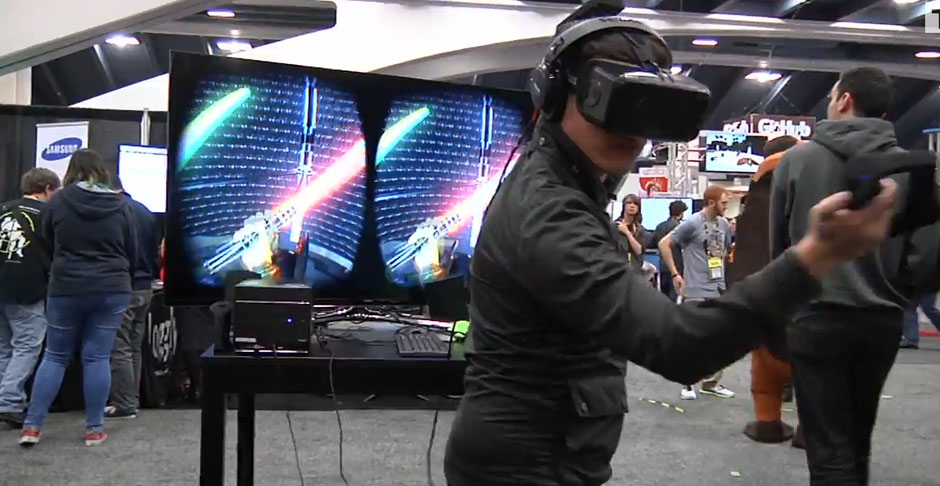I recently followed CES 2016 online – the world’s biggest technology show taking place in Las Vegas, to see what technologies and predictions from big tech brands will unravel in the next year.
Wearable technology and smart homes were the most dominant themes in the show, but among all the exciting tech and gadgets, the one that still ignites my curiosity and excitement is Virtual Reality (VR).
VR technology seems to be gaining momentum everywhere these days, especially in the last year with Facebook buying Oculus and Sony releasing Project Morpheus, expectation is high about 2016 being the year of Virtual Reality!
VR Tech gadgets like the Samsung Gear VR, Oculus Rift, HTC Vive, and PlayStation VR all had crowded rooms in the CES 2016 show with some of them announcing their gadgets’ release into the mainstream.
At this point I think that the technology has matured enough to be released in the market and have a massive potential impact! VR does not only create incredible 3D environment but also can stimulate your mind bringing you into the experience as an active participant rather than a casual observer. Being immersed in the virtual world in addition to having audio narration, instructing you to participate in physical gestures such as grabbing, selecting, and moving made possible with gesture controllers allows a sense of greater control of the virtual experience. A good example of that is Sixense STEM system by Samsung offering a full-body controlled presence and experience in Virtual Reality as it provides motion controls, haptic feedback, and additional spatial awareness in VR .

Virtual Reality Lightsaber Demo with Sixense STEM!
So is VR going to be a game changer and will there be any difference in the use of VR after it is made available for public?
I have been captivated by one of the very impressive examples of using VR in CES 2016, NASA giving visitors a virtual “ride on board an Orion spacecraft and a you-are-there perspective of the Kennedy Space Centre”. Using headsets like Oculus Rift and Microsoft Hololens, people who were there at the show were fortunate to experience NASA’s latest rocket, the experience that people described as “blasting”. Actually NASA has already started using VR to train astronauts for one of the most dangerous journeys of their lives, it allows astronauts to experience what it feels like to survive problems they might face at work. The Martian VR Experience can transports users to Mars, a place they have never been to, and let astronauts experience what Watney had to go through to survive alone in Mars.A full Martian VR experience will be realised later in the year and is expected to be very compelling and immersive experience, which is through exploiting the interactive features of any of the Rift, the Vive, or the PSVR, users will be engaged in the different scenarios recreated based on the film in VR . For me, this is game changer. NASA pushes VR to its limits.
“in space, an astronaut’s next, minutes are never guaranteed. They have to adjust to the drastically modified rules of physics and to a calmness and a slowness that makes danger”
Here is the video demo to the Martian VR experience:
For me “experience” is the key to the success of this example as there is no other way on Earth to replicate this experience other than VR.
How this applies to Education?
Let’s take this example and try to think forward how it can benefit our education and students because it is not enough to release these fancy gadgets every year, talk about them, try them, and then say “yea, they are cool”, and end up putting them on the shelf to gather some dust! What really makes this technology and its function a game changer is the experience having a clear purpose and real context.
Thinking about the example of NASA and astronauts training this could also be applied in classes of astronomy. For example, astronomy students can learn about the solar system and how it works by physical engagement with the objects within. They can move planets, see around stars and track the progress of a comet. This also enables them to see how abstract concepts work in a three dimensional environment which makes them easier to understand and retain.
I can see a lot of potentialities of VR in education, it can certainly bring value to education and training but what we really need to do is to start creating experiences – both virtual and augmented experiences – ones that are authentic and long lasting, aiming for more than just blowing students’ minds. In addition, these experiences should be targeted at real problems.
VR experiences are no more for one person at a time!
The possibility of thought-controlled motion is particularly exciting. VR is not anymore a way to experience environment and situations independently. You can now invite people to the visual experience that you are in. The toy box demo developed by Oculus is a way of testing its Touch Controllers and experimenting with the many ways people can interact virtually.
Mark Zuckerberg called the zero-gravity ping-pong “the craziest Oculus experience I’ve had recently.” And, he said, “What’s really amazing is sharing these experiences with your friends.”
In the classroom, a lot of the activities are group work such as gaming activities. What would make any VR experience unique and immersive for learners is immediacy of feedback and interaction, this can enable them to have control over the learning experiences. See how Anatomic learning which is central to all areas of medical training or education can find extreme use of VR simulator especially with the use of touch controller.
Here is an example of heart anatomy developed by Leap Motion and is made available for free for users.
However, it is important to know how to make benefit and use of these immersive experiences that these technologies enable. How schools, universities and colleges can find value in these applications within their educational contexts.
Virtual reality has the capacity to support problem based and inquiry based learning enabling performance-based assessment particularly in STEM learning in a safe learning environment. Encouraging educational institutions to create more room for STEM programs to expose young people to a more active and inquiry-based approach has become essential to me as part of my work at Jisc. I believe that if we provide students with opportunities to master what they learn and really own what they learn for themselves, we will be better placed to support all students including those with accessibility needs to a high standard. This is the challenge I am currently engaged in as my job as a developer in Jisc Future Technologies, working side by side with universities and colleges, including their staff and students, to make the most out of teaching and learning.
Technology is here all around us and it is changing our lives day by day, however, if we do not embrace it to its fullest and create transformative opportunities, we will end up falling short of its grandiose aspirations.
For those of you who could not make it to CES 2016, here is a VR tour hosted by CNET of the CES show floor that you can watch in VR using Google Cardboard or Samsung Gear VR.






